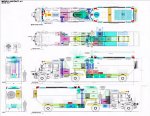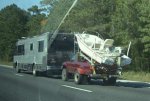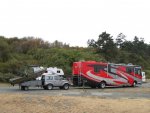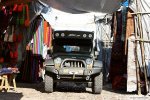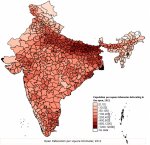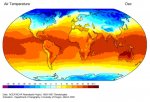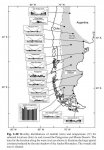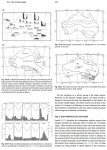biotect
Designer
.
CONTINUED FROM PREVIOUS POST
****************************************
PART Cv:
Fundamental Assumption Five -- The TERRALINER and its TOAD will be conceptually, physically, and programmatically distinct
****************************************
1. The Right Vehicle for a Specific Mission Profile
****************************************
In the various “Action Shots” that Earthroamer provides on its website, it demonstrates the undoubted virtues of a small, low-height, ultra-compact vehicle like the XV-JP (a discontinued model) -- see http://earthroamer.com/employees-facilities/previous-designs/xv-jp/ , http://www.earthroamer.com/tab_xpedition_vehicles/xvjp5_specs.html and http://www.earthroamer.com/galleries/xv-jpinaction/index.htm . For instance, under-foliage clearance:




The last image also demonstrates what one might call “under-souk” or “under-outdoor-shaded-market” clearance……:sombrero:
Some of those who've been following the thread may think that I am a “size-freak”, and that for me bigger is always better. It is simply not true. I fully recognize the value of smaller vehicles like Jeeps, Defenders, G-wagens, and Toyota Landcruisers. For exploring unknown dirt tracks where a simple thing like a big tree-branch that overhangs a road might block passage for larger vehicles, a compact SUV is preferable.
But that does not mean that a compact SUV is the vehicle of choice for full-time, camper-based living. For full-timing, I think it's equally clear that a vehicle the size of an American Class-A motorhome, with a full set of slide-outs, is preferable. For most people.
Sure, there do exist people who travel the world in just an SUV, most famously, Gunther Holtorf, who spent 23 years living out of his G-wagen – see http://www.bbc.co.uk/news/special/2014/newsspec_8703/index.html#one-1659 to http://www.bbc.co.uk/news/special/2014/newsspec_8703/index.html#seven-3990 , http://www.bbc.com/news/magazine-29505145 , http://www.digitaltrends.com/home/t...23-year-500000-mile-journey-around-the-world/ , http://www.dailymail.co.uk/travel/t...ing-556-000-miles-215-countries-mercedes.html , http://www.autoblog.com/2014/10/16/...n-on-557k-mile-26-year-road-tr/#slide-3017826 , http://www.outsideonline.com/1912491/worlds-greatest-traveler-1988-mercedes-has-been-172-countries , and http://www.outsideonline.com/1912491/worlds-greatest-traveler-1988-mercedes-has-been-172-countries .
But travelling this way has consequences.
For instance, as egn so wonderfully put things early on in the thread, there is the “wife acceptance factor” to consider. After his first extended trip to Africa, Gunther and his third wife, Beate, got a divorce. Was Gunther's expectation that they should spend the next few decades living out of an SUV the main reason? Who knows. After all, she was his third wife. But one can easily imagine that this is not the kind of travelling she had a stomach for.
Gunther then got realistic, put an ad in the personals column of Die Zeit, and found his fourth wife Christine. With Christine he spent the next 20 years almost continuously on the road, racking up over 800,000 km in “Otto”, the same G-wagen that he started with. So sure, for some people living for decades out of an SUV is their idea of a good time. But not for most.
This is what it looks like:






****************************************
CONTINUED IN NEXT POST
.
CONTINUED FROM PREVIOUS POST
****************************************
PART Cv:
Fundamental Assumption Five -- The TERRALINER and its TOAD will be conceptually, physically, and programmatically distinct
****************************************
1. The Right Vehicle for a Specific Mission Profile
****************************************
In the various “Action Shots” that Earthroamer provides on its website, it demonstrates the undoubted virtues of a small, low-height, ultra-compact vehicle like the XV-JP (a discontinued model) -- see http://earthroamer.com/employees-facilities/previous-designs/xv-jp/ , http://www.earthroamer.com/tab_xpedition_vehicles/xvjp5_specs.html and http://www.earthroamer.com/galleries/xv-jpinaction/index.htm . For instance, under-foliage clearance:




The last image also demonstrates what one might call “under-souk” or “under-outdoor-shaded-market” clearance……:sombrero:
Some of those who've been following the thread may think that I am a “size-freak”, and that for me bigger is always better. It is simply not true. I fully recognize the value of smaller vehicles like Jeeps, Defenders, G-wagens, and Toyota Landcruisers. For exploring unknown dirt tracks where a simple thing like a big tree-branch that overhangs a road might block passage for larger vehicles, a compact SUV is preferable.
But that does not mean that a compact SUV is the vehicle of choice for full-time, camper-based living. For full-timing, I think it's equally clear that a vehicle the size of an American Class-A motorhome, with a full set of slide-outs, is preferable. For most people.
Sure, there do exist people who travel the world in just an SUV, most famously, Gunther Holtorf, who spent 23 years living out of his G-wagen – see http://www.bbc.co.uk/news/special/2014/newsspec_8703/index.html#one-1659 to http://www.bbc.co.uk/news/special/2014/newsspec_8703/index.html#seven-3990 , http://www.bbc.com/news/magazine-29505145 , http://www.digitaltrends.com/home/t...23-year-500000-mile-journey-around-the-world/ , http://www.dailymail.co.uk/travel/t...ing-556-000-miles-215-countries-mercedes.html , http://www.autoblog.com/2014/10/16/...n-on-557k-mile-26-year-road-tr/#slide-3017826 , http://www.outsideonline.com/1912491/worlds-greatest-traveler-1988-mercedes-has-been-172-countries , and http://www.outsideonline.com/1912491/worlds-greatest-traveler-1988-mercedes-has-been-172-countries .
But travelling this way has consequences.
For instance, as egn so wonderfully put things early on in the thread, there is the “wife acceptance factor” to consider. After his first extended trip to Africa, Gunther and his third wife, Beate, got a divorce. Was Gunther's expectation that they should spend the next few decades living out of an SUV the main reason? Who knows. After all, she was his third wife. But one can easily imagine that this is not the kind of travelling she had a stomach for.
Gunther then got realistic, put an ad in the personals column of Die Zeit, and found his fourth wife Christine. With Christine he spent the next 20 years almost continuously on the road, racking up over 800,000 km in “Otto”, the same G-wagen that he started with. So sure, for some people living for decades out of an SUV is their idea of a good time. But not for most.
This is what it looks like:






****************************************
CONTINUED IN NEXT POST
.
Last edited:










